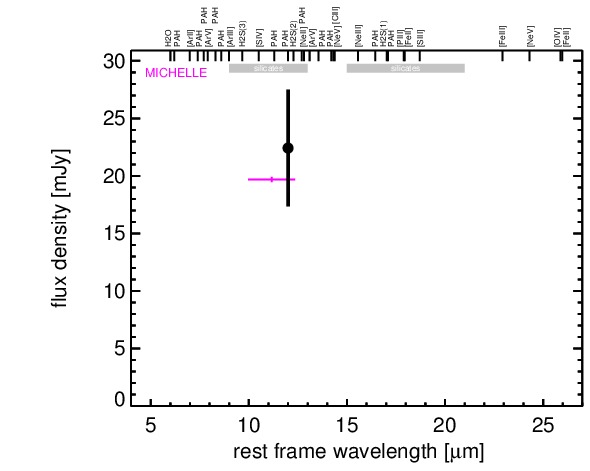Sasmirala Individual Information for NGC 3718
Description
NGC 3718 is a peculiar early-type spiral galaxy at a distance of D = 17.0 ± 3.4 Mpc [tully_nearby_1988] with a broad-line LINER nucleus [veron-cetty_catalogue_2010], covered by a prominent dust lane, which completely absorbs the nuclear UV signature [barth_search_1998]. A compact radio source with a possible jet extending 0.5arcsec ~ 40 pc to the north-west was detected [nagar_radio_2002, krips_nuclei_2007]. Also only very weak extended NLR emission was detected [pogge_narrow-line_2000]. The first MIR observations of NGC 3718 were performed with IRTF but the nucleus was not clearly detected [lonsdale_infrared_1984, willner_infrared_1985, devereux_infrared_1987]. The are no cryogenic Spitzer observations available for NGC 3718. In the WISE band 3 image, it appears a compact nuclear source embedded within elliptical host emission turning into an S-shaped bar at larger distances, resembling the dust lane. The nuclear region of NGC 3718 was imaged with Michelle in the N’ filter in 2008 [mason_nuclear_2012], and a compact MIR nucleus was detected. The nucleus is possibly marginally resolved (FWHM ~ 0.47arcsec ~ 39 pc) but this is insufficient for a robust classification of the nuclear extension in the MIR at subarcsecond scales. Our nuclear photometry is consistent with [mason_nuclear_2012].
- [barth_search_1998] Aaron J. Barth, Luis C. Ho, Alexei V. Filippenko, and Wallace L. W. Sargent. A search for ultraviolet emission from LINERs . ApJ , 496 pp. 133, March 1998.
- [devereux_infrared_1987] Nicholas A. Devereux, E. E. Becklin, and Nick Scoville. Infrared characteristics of the nuclei of normal galaxies . ApJ , 312 pp. 529–541, January 1987.
- [krips_nuclei_2007] M. Krips, A. Eckart, T. P. Krichbaum, J.-U. Pott, S. Leon, R. Neri, S. García-Burillo, F. Combes, F. Boone, A. J. Baker, L. J. Tacconi, E. Schinnerer, and L. K. Hunt. NUclei of GAlaxies. v. radio emission in 7 NUGA sources . A&A , 464 pp. 553–563, March 2007.
- [lonsdale_infrared_1984] C. J. Lonsdale, S. E. Persson, and K. Matthews. Infrared observations of interacting/merging galaxies . ApJ , 287 pp. 95–107, December 1984.
- [mason_nuclear_2012] R. E. Mason, E. Lopez-Rodriguez, C. Packham, A. Alonso-Herrero, N. A. Levenson, J. Radomski, C. Ramos Almeida, L. Colina, M. Elitzur, I. Aretxaga, P. F. Roche, and N. Oi. The nuclear infrared emission of low-luminosity active galactic nuclei. AJ , 144 pp. 11, July 2012.
- [nagar_radio_2002] N. M. Nagar, H. Falcke, A. S. Wilson, and J. S. Ulvestad. Radio sources in low-luminosity active galactic nuclei. III. ``AGNs'' in a distance-limited sample of ``LLAGNs'' . A&A , 392 pp. 53–82, September 2002.
- [pogge_narrow-line_2000] Richard W. Pogge, Dan Maoz, Luis C. Ho, and Michael Eracleous. The narrow-line regions of LINERS as resolved with the hubble space telescope . ApJ , 532 pp. 323–339, March 2000.
- [tully_nearby_1988] R. Brent Tully. Nearby galaxies catalog . Cambridge University Press, 1988.
- [veron-cetty_catalogue_2010] M.-P. Véron-Cetty and P. Véron. A catalogue of quasars and active nuclei: 13th edition . A&A , 518 pp. 10, July 2010.
- [willner_infrared_1985] S. P. Willner, M. Elvis, G. Fabbiano, A. Lawrence, and M. J. Ward. Infrared observations of LINER galactic nuclei . ApJ , 299 pp. 443–461, December 1985.
Images

Optical image (DSS, red filter). Displayed are the central 4 arcmin with North being up and East to the left. The colour scaling is linear with white corresponding to the median background (BG) and black to the 0.01% pixels with the highest intensity.

Subarcsecond-resolution MIR images sorted by increasing filter central wavelength. Displayed are the inner 4 arcsec with North being up and East to the left. The colour scaling is logarithmic with white corresponding to median BG and black to the 75% of the highest intensity of all images in units of sig_bg. The inset image (where present; either bottom or top right) shows the central arcsecond of the PSF from the calibrator star, scaled to match the science target. The labels in the bottom left state instrument and filter names (C: COMICS, M: Michelle, T: T-ReCS, V: VISIR).
SEDs


MIR SED. The description of the symbols in all the SED plots (where present) is the following: Grey crosses and solid lines mark the Spitzer/IRAC, MIPS and IRS data. The colour coding of the other symbols is as follows: green for COMICS, magenta for Michelle, blue for T-ReCS and red for VISIR data. Darker-coloured solid lines mark spectra of the corresponding instrument. The black filled circles mark the nuclear 12 and 18 micron continuum emission estimate from the data (where present). The ticks on the top axis mark positions of common MIR emission lines, while the light grey horizontal bars mark wavelength ranges affected by the silicate 10 and 18 micron features.